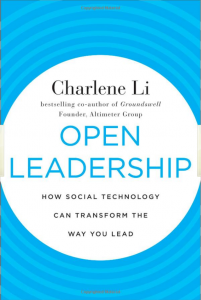Gain Control By Giving It Up
 Charlene Li’s new book will be out in a few weeks, and if you’re interested in how social media is transforming the way business gets done, you’ll want to pick up a copy.
Charlene Li’s new book will be out in a few weeks, and if you’re interested in how social media is transforming the way business gets done, you’ll want to pick up a copy.
The book is called Open Leadership, and I would classify it as the first of the post-social media books. By that I mean that it looks at the consequences democratized communications rather than at the media itself. Expect to see wave of similar books in the coming years. This one is a very good first entry. Open Leadership will make a lot of people uncomfortable because it proposes that the only way to govern effectively in a transparent business world is to give up control and trust people to do the right thing. Li makes a persuasive case by citing many examples of companies that have done exactly that with great success.
Li is a former Forrester Research analyst, founder of Altimeter Group and co-author of Groundswell, the breakthrough 2008 book that provided the first demographic profiles of social media users as well as a rigorous methodology for evaluating the ROI of social programs. In Open Leadership, she builds on some of the economic models first presented in Groundswell, but the new book is more of a call to action than a financial exercise.
The premise is encapsulated in the title of Chapter 1: “Why Giving up Control Is Inevitable.” Li asserts that today’s business world is too complex and competitive to permit organizations to continue to manage the way they have since the Industrial Revolution. That top-down philosophy assumes that people who can’t accomplish tasks without instructions, rigid rules and constant oversight are idiots. That worked okay when companies had some control over their environment, but today too many factors are out of their hands. So one man’s story of how an airline broke his guitar and refused to fix it becomes a cultural sensation while the airline stands by helplessly and fumes.
 Li (left) asserts that the only way to gain any level of control over today’s turbo-charged business environment is to give up as much control as possible. New business leaders set examples, demonstrate confidence and create cultures that tolerate intelligent, well-intentioned failure. And guess what? It turns out that when smart people are given the latitude to make decisions, they tend to make better ones than if someone else makes decisions for them.
Li (left) asserts that the only way to gain any level of control over today’s turbo-charged business environment is to give up as much control as possible. New business leaders set examples, demonstrate confidence and create cultures that tolerate intelligent, well-intentioned failure. And guess what? It turns out that when smart people are given the latitude to make decisions, they tend to make better ones than if someone else makes decisions for them.
Open Leadership provides some refreshing new examples of how this new management philosophy is working:
- Meetup.com replaced a top-down approach to project management with one that requires stakeholders to persuade engineers to spend time on their projects. Productivity exploded;
- BestBuy outlasted competitors in the brutal electronics retailing business in part by developing a culture that lets its employees guide customers toward the best decision, even if that means buying from a competitor;
- Electronics distributor Premier Farnell distributed low-cost digital video cameras to every employee in the company so that they could document their best practices and share them on an internal network. Employees are more empowered and the quality of information is better.
Li is particularly inspired by John Chambers, the CEO of Cisco, which has undertaken a massive program to drive decision-making down to local levels. Chambers says the idea unnerved him at first, but that Cisco is now a faster, more responsive and more innovative company as a result. And he’s working fewer hours. Chambers provides critical support for the concepts outlined in Open Leadership; he has the unwavering support of Cisco’s board of directors, which enables him to talk honestly about his own reservations and the mistakes he has made.
It is on the issue of mistakes that the author is most emphatic. Li stresses that businesses can only be innovative if they learn to accept the fact that failure is a necessary by-product of risk-taking. Companies that successfully practice open leadership evaluate decisions based upon the thought that goes into them rather than the results. Failure is an opportunity to learn and try again, and the only unpardonable sin is making the same mistake twice.
Most businesses do a lousy job of this. They publicly declare a commitment to innovation, but privately punish employees whose ideas don’t succeed. Tolerance for failure is sometimes cited as the most important reason that Silicon Valley has outclassed every other region of the U.S. in technology innovation. Reading Open Leadership, I get the impression that such tolerance is the only option for businesses that hope to lead in uncertain markets.
B-to-B Social Marketing — Really!
My new presentation on social marketing for b-to-b companies drew a nice audience at NewComm Forum last week, and many people have asked about the slides. The presentation, entitled “B-to-B Social Media – Really!” cites numerous examples of businesses that have applied all sorts of new communication tools to building brand, generating leads and improving customer support. It’s available on SlideShare, along with all my other past presentations, and you are free to download it and use it as you wish. As always, I appreciate attribution. I’d appreciate even more a chance to present my findings to your company or professional association.
Tip of the Week: OffiSync
I love Google Documents, the suite of office applications that lets people collaborate on text files, spreadsheets and presentations without worrying about version control or synchronization. Dana and I wrote Joy of Geocaching on Google Docs and found it to be a godsend when we weren’t at home but still needed to access each other’s files.
Google Docs has shortcomings, however. The apps aren’t nearly as feature-rich as Microsoft Office, so fancy formats and off-beat fonts aren’t nearly as easy to use. Also, applications delivered online run more slowly than those that run on a fast PC. I’d say I’m twice as productive with Word as I am with Google’s rudimentary word processor.
OffiSync is finding a middle ground. This hot startup has come up with a cool utility that runs inside Microsoft Office and automatically connects to Google Docs as a back-end. You can load and save Docs files as if they were on your local hard drive. The tool also integrates Google search and real-time collaboration, meaning that is two or more people are working on a file simultaneously, their changes are synchronized every time they save to the server.
These high-end features are only available in the paid version of the product, which sells for a modest $12 annual fee, but the free version does a good job of managing the back-end interaction with the server. Your creativity is limited by the least common denominator or Google Docs support, but if you want to enjoy the power of local Word apps while shortcutting the tedious process of sending files to and from the server, this tool is pretty sweet. Here’s the download link.
Just for Fun: Those Nutty Skydivers
 Skydiving looks like fun. And if it wasn’t for pesky things like responsibility and the fact that they can’t guarantee I’d live through it, I would have done it years ago. So I respect people all the more who not only skydive, but do so on a regular basis and attempt to set records. Woman’s Day collected 10 pictures of phenomenal feats of people flinging themselves from mountaintops and airplanes. We just hope all of them made it safely to the ground!
Skydiving looks like fun. And if it wasn’t for pesky things like responsibility and the fact that they can’t guarantee I’d live through it, I would have done it years ago. So I respect people all the more who not only skydive, but do so on a regular basis and attempt to set records. Woman’s Day collected 10 pictures of phenomenal feats of people flinging themselves from mountaintops and airplanes. We just hope all of them made it safely to the ground!

 I don’t go to the
I don’t go to the 
